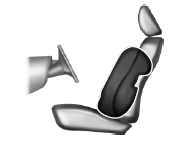Side airbags
WARNING: Do not place objects or mount equipment on or near the airbag cover, on the side of the seat backs (of the front seats), or in front seat areas that may come into contact with a deploying airbag. Failure to follow these instructions may increase the risk of personal injury in the event of a crash.
WARNING: Do not use accessory seat covers. The use of accessory seat covers may prevent the deployment of the side airbags and increase the risk of injury in an accident.
WARNING: Do not lean your head on the door. The side airbag could injure you as it deploys from the side of the seat back.
WARNING: Do not attempt to service, repair, or modify the airbag, its fuses or the seat cover on a seat containing an airbag, as you could be seriously injured or killed. Contact your authorized dealer as soon as possible.
WARNING: If the side airbag has deployed, the airbag will not function again. The side airbag system (including the seat) must be inspected and serviced by an authorized dealer. If the airbag is not replaced, the unrepaired area will increase the risk of injury in a crash.
The side airbags are located on the outboard side of the seat backs of the front seats. In certain lateral crashes, the airbag on the side affected by the crash will be inflated. The airbag was designed to inflate between the door panel and occupant to further enhance the protection provided occupants in side impact crashes.

The system consists of the following:
• a tag on the seat back indicating that side airbags are found on your vehicle
• side airbags located inside the seat back of the driver and front passenger seats.

• crash sensors and monitoring system with readiness indicator. See Crash
Sensors and Airbag Indicator later in this chapter.
• front passenger sensing system.
Note: The passenger sensing system will deactivate the passenger seat-mounted side airbag if it detects an empty passenger seat.
The design and development of the side airbag system included recommended testing procedures that were developed by a group of automotive safety experts known as the Side Airbag Technical Working Group. These recommended testing procedures help reduce the risk of injuries related to the deployment of side airbags.
See also:
Reverse sensing system (if equipped)
The reverse sensing system (RSS) sounds a tone to warn the driver of obstacles
near the rear bumper when R (Reverse) is selected and the vehicle is moving at speeds
less than 3 mph (5 km/h). The s ...
Using snow chains
WARNING: Snow tires must be the same size, load index and speed rating
as those originally provided by Ford. Use of any tire or wheel not recommended by
Ford can affect the safety and performance ...
Rear seats
Second row adjustable head restraints
Your vehicle is equipped with second row outboard and center head restraints
that are vertically adjustable.
WARNING:
To minimize the risk of neck injury ...
